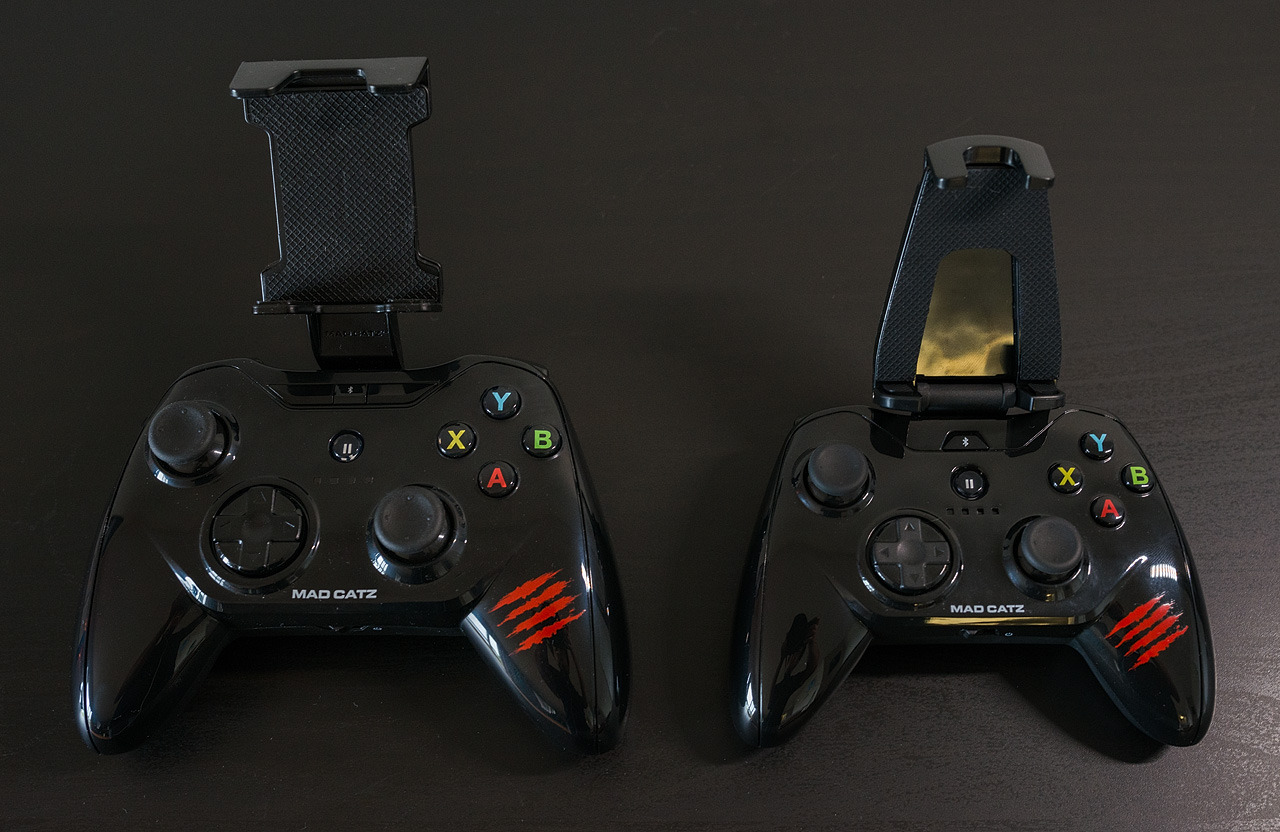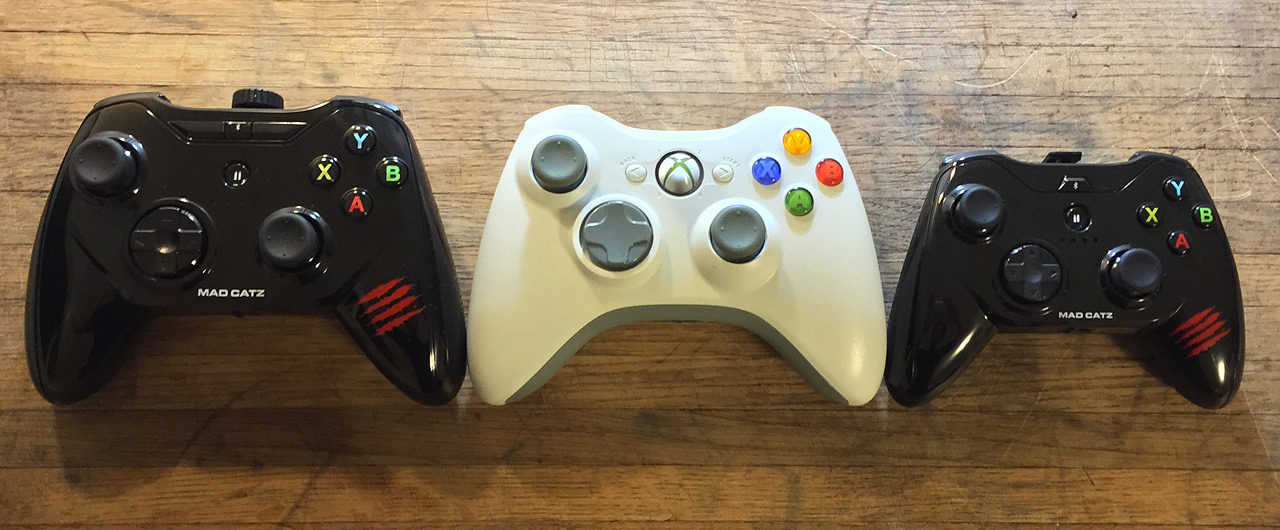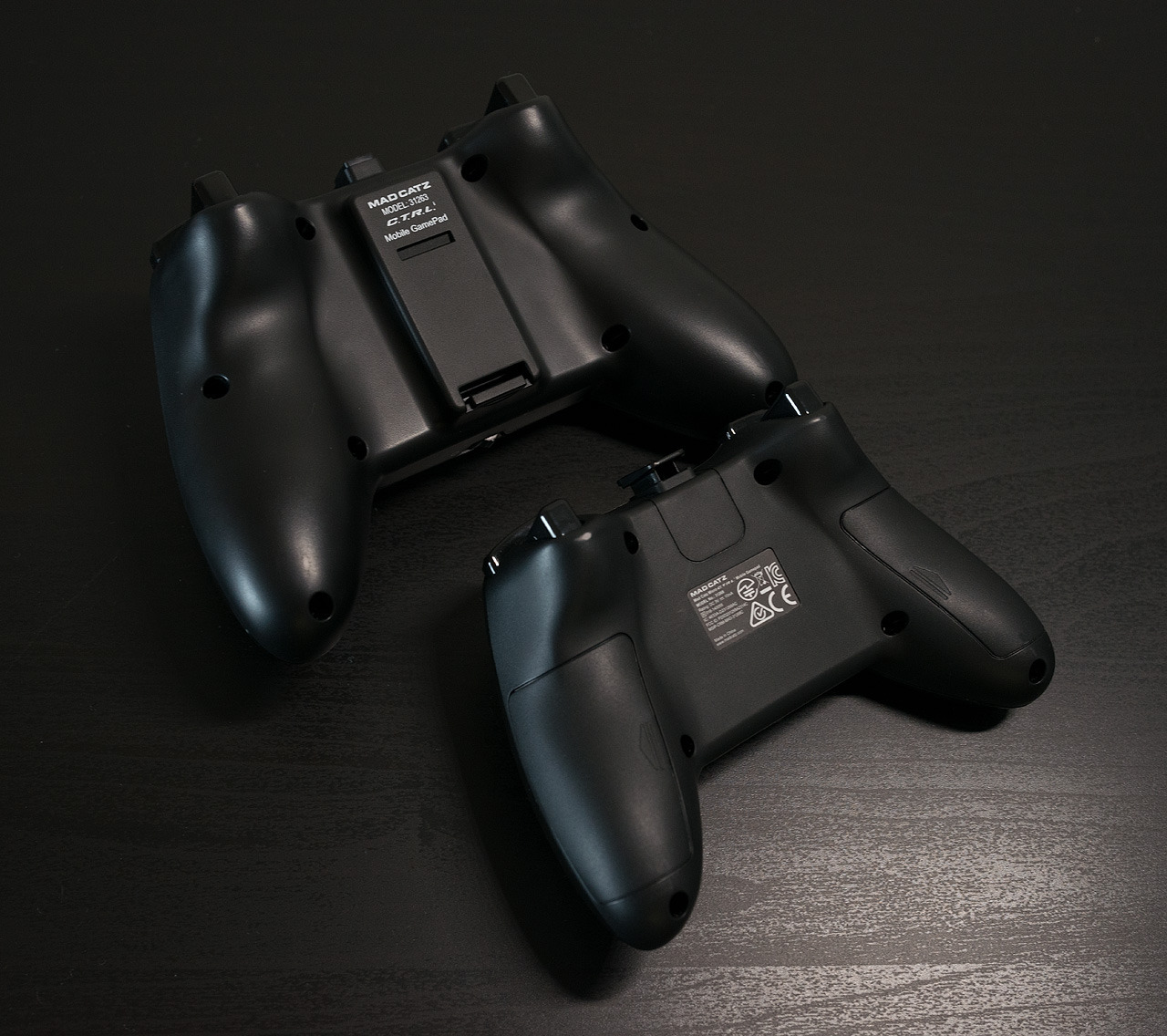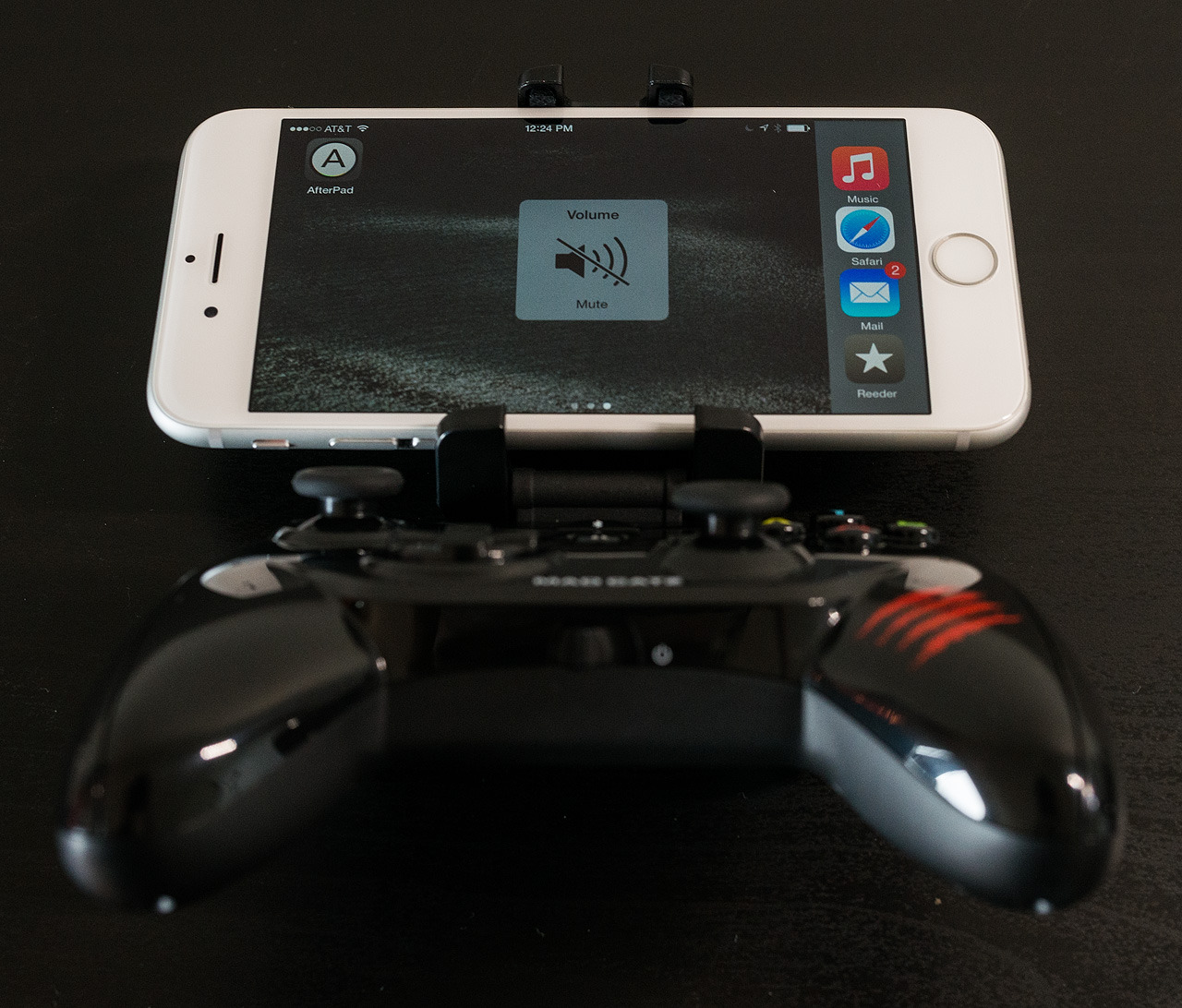Mad Catz Micro C.T.R.L.i – The AfterPad Review
Two different controllers, two interpretations of a solid design, both at surprisingly reasonable prices. Iâll be reviewing each separately, as they have different strengths and weaknesses. But as the Micro is the most reasonably priced MFi controller yet at a cost of $49, I figured I might as well start there. So without further ado, here is the complete AfterPad controller review of the Mad Catz Micro C.T.R.L.i.
Design
If the C.T.R.L.i was released a few months ago, itâs mere existence would be enough to earn it the title of Best MFi Controller. However, as weâre now getting a wealth of controller options over the holiday season, it isnât enough for the C.T.R.L.i to merely work correctly as a controller. It has to be comfortable, it has to be well built, and it has to be nice to look at.
Visuals
The top of the controller is clad in glossy black plastic; other color options are coming soon, but black will likely be the only choice for the next few months. The right handle grip features a cosmetic touch: some sort of orange-red scratch mark, apparently indicative of the Mad Catz branding. The underside of the controller is a lightly textured matte plastic, with occasional screw holes.
Visually⦠well, it is what it is. Mad Catz has opted for an aggressively-branded âgamerâ focused look. Never mind that these are iOS controllers, and the iOS ecosystem doesnât fit this look in any way. To Mad Catz, their âbrandâ comes first. If you have a ton of other Mad Catz products, then hey, this one will fit right in. If youâre an average iOS gamer looking for an iOS accessory, this one is going to stick out like a sore thumb. Itâs not an objectively ugly controller. Itâs just⦠not a very Apple-ish one.

Feel
The good news is, while the visuals may be a bit overstated, the feel of the Micro C.T.R.L.i is first-rate. Glossy plastic can feel cheap when done poorly, but THIS glossy plastic feels high quality. Fingerprint magnet or not. The matte plastic on the rear of the controller better still. Itâs a world of difference between this matte plastic and the style used by the MOGA and Logitech controllers – this plastic just screams quality. The screw holes on the bottom of the controller are present, but arenât noticeable during gameplay. Visually, while the controller looks like it is covered in noticeable seams, they donât arenât actually noticeable on your skin during play. It isnât the seamless, screwless beauty of the Xbox Oneâs controller, but it still feels nice.
Size-wise, the Micro controller is small, but not cramped. This does NOT feel like a mobile controller. Spacious buttons and an intelligently designed controller layout make for a decidedly console-style play experience. On the other hand, the analog sticks have been shrunk down in size along with the controller, leading to what is perhaps my biggest complaint – these slightly smaller analog sticks just arenât as spacious as the full sized sticks on the regular C.T.R.L.i. Still, they donât feel bad – in fact, nothing on the Micro C.T.R.L.i does. This is the first MFi controller that actually FEELS worth itâs price.

The Controller
Analog Sticks
The Micro C.T.R.L.i is outfitted with two diagonally-staggered analog sticks. Visually, they are almost identical to those of the Xbox 360âs controller – they are coated in a relatively grippy dark gray rubberized exterior, and feature 4 protruding lumps in the middle of lightly concave tips. It is more grippy than the textureless analog sticks of the Rebel, and a bit less grippy than the rubberized caps of the Stratus.
The Micro controller features noticably smaller, shallower, and slightly looser sticks compared with the full-size C.T.R.L.iâs. This has the effect of making the sticks easier to move, at a slight expense of precision. While I find full-size analog sticks of the regular C.T.R.L.i more pleasant to use, there is nothing inherently wrong with those of the Micro C.T.R.L.i. These are well-built and precise analog sticks without the quality compromises of the Stratus controller, just at a noticeably smaller size than those of traditional console controllers. They are far superior to the shrunken sticks of the SteelSeries controller, and a world of difference from the circle pads of the MOGA Ace Power.
While full-size analog sticks can occasionally feel a bit large and unwieldy, these ones definitely verge on the small size. To my medium-sized hands, the small analog sticks of the Micro C.T.R.L.i feel a little bit smaller than Iâd like. In almost every situation, these sticks were perfectly fine, but in the most demanding situations, I found my thumbs slipping due to the lack of surface area; running down the path while being chased by a giant boulder in Crash Bandicoot 2 was made extra-difficult by the small stick size, especially compared with the luxuriously-sized PlayStation analog sticks the game was designed for. Controlling the camera in Call of Duty was more twitchy and less responsive than I was used to with the large-sticked Xbox controller, due mostly to the smaller radius of these sticksâ design.

ABXY Buttons
The quality and design of the face buttons is one of the most important aspects of any game controller. Size, spacing, and texture are important aspects to consider – how far apart are the buttons? How large are they? How grippy vs smooth? How deep do they press down? These arenât qualities that have a right or wrong answer; they come down almost entirely to matters of personal preference. Button size brings inherent trade-offs in gameplay – it is easier to hit larger and wider spaced buttons without inadvertently touching any other buttons, but at the same smaller buttons are easier to combine-press to create combos.
Size-wise, the face buttons on the Micro C.T.R.L.i are a little bit smaller and a little bit closer together than those of a traditional console controller. Interestingly enough, MFi controller buttons are generally far smaller and closer than those of traditional console controllers – in fact, only the full-size C.T.R.L.i has larger and wider spaced buttons than these, and despite being the largest MFi controller of all, the Rebelâs buttons are smaller and tighter together. Objectively, the Micro C.T.R.L.i has relatively mid-sized buttons – they donât stray too large or too small, and should be easy enough to use for fans of both large and small buttons.
This âmiddle pathâ execution extends beyond size. The depth these buttons travel when pressed is neither deep nor shallow when compared with those of console controllers, managing to be shallower than those of the C.T.R.L.i and Stratus controllers, but deeper than those of the Rebel and the iPhone-specific controllers. The surface texture is glossy and polished; similar to the surface of the Xbox and standard C.T.R.L.i controllers, less grippy than the surface of the Stratus controller, and less smooth than the matte surfaces of the PlayStation and MOGA Rebel controllers.
Ultimately, the face buttons on the Micro C.T.R.L.i are well built, unopinionated options that should serve the needs of a lot of different gamers. Unless you feel very strongly about button size, you have nothing to worry about on this front.

The d-pad
I wish I had something good to say about the d-pad here, but I donât. Itâs terrible. Less terrible than some of the other options, sure. The Rebel, PowerShell, Ace Power, and even the full-size C.T.R.L.i all have worse d-pads. Thatâs fine, but this d-pad is still terrible. The size is okay, and the surface shape is nice, but the feel is stiff, imprecise, and cheap. Itâs a big letdown on an otherwise solid controller.
Iâm not sure what the problem is with MFi controller makers and d-pads. Apple mandates the circular design, but plenty of controllers have shipped with decent circular d-pads. Heck, my favorite PlayStation 2 controller features a circular d-pad. This CAN be done well. SteelSeries did an okay job with the d-pad on their Stratus controllers, and the d-pad on the Razer Junglecat is solid. Not sure why Mad Catz, MOGA, and Logitech keep dropping the ball so badly here.
Anyways, in my testing, the d-pad performed adequately. Itâs not a fun way to play, but it works. Youâll want to use the analog sticks at every available opportunity, though; even on side-scrollers that would otherwise benefit from a solid d-pad.
The Triggers and Shoulder Buttons
The rear input method style is one place that MFi controller makers are allowed a little bit of flexibility by Apple in terms of their approach. Every controller must feature a right and left shoulder bumper button, and Extended-layout controllers like the Micro C.T.R.L.i come outfitted with an additional right and left input. This input can be in the form of two additional shoulder buttons, as in the Horipad and Stratus, or in the form of gun-style triggers, as opted for by the Moga and Mad Catz controllers.
This trigger-style design is generally better for games where precise control is required, such as racing games where the trigger pressure corresponds to acceleration rate; and for games where pulling a trigger makes sense, such as shooters. In games where the lower shoulder is âjust another buttonâ, the trigger metaphor probably makes less sense than including another bumper. Triggers probably make more sense going forwards for new games, with the growing popularity of shooters outpacing most other genres. Retro gamers may prefer controllers with L2 and R2 shoulder buttons instead, as the vast majority of games throughout history were not designed for triggers.
But anyways, back to the Micro C.T.R.L.i specifically. What weâre dealing with here is a controller with a standard-style shoulder button on the left and right side and two glossy triggers below them. The shoulder buttons have a semi-gloss design, and with the exception of their smaller size, they feel similar to those of an Xbox 360 or PlayStation controller. Moving your pointer fingers from resting on the triggers to hitting the shoulder buttons doesnât require any special finger gymnastics. Nothing particularly special to report here one way or the other – they work, theyâre easy to hit, and they feel pleasant to the touch.
The triggers are squarely in the vein of the Xbox 360 design (no PlayStation 3 trigger nightmare here), are relatively small in size, and centered directly in the center of their respective shoulder buttons. They require a medium amount of pressure to hit – far lower than the Rebelâs high-pressure triggers, and comparable to the Xbox 360âs triggers. They feel relatively solid, though there is a bit more wobble on these triggers than on those of the full-size C.T.R.L.i, not to mention the extremely solid feeling Rebel triggers. Resting your fingers on these triggers is not enough to activate them, which is good for games that map precise activities to light trigger pressure.

Other Buttons
Rounding out the button selection, the Micro C.T.R.L.i features the MFi-standard Pause button, a bluetooth pair button in the top-center of the controller, and a somewhat odd spring-loaded âpower switchâ along the base of the controller, between the handles. The Pause button feels solid, though you probably wonât spend much time pressing it. The bluetooth pair button looks a little strange on top of the controller, but it likely takes the shape it does to conform with the design of the Android version of this controller, which uses that space to include a series of media controls. Same story for the spring loaded power switch on the bottom of the controller – that space is used to select modes on the Android version, and was probably repurposed for this iOS model.
The Software
A great controller is nothing without working drivers – just ask MOGA. Similarly, any decent controller should come with a way to update drivers to address unforeseen issues without requiring a warranty return or a hunt for a PC to install with – just ask SteelSeries. Anyways, although the C.T.R.L.i line appears to work great out of the box, Mad Catz has answers to both of these problems ready to go.
The Driver
This comes as a breath of fresh air: The drivers for the Micro C.T.R.L.i actually appear to work as advertised. In my week or two of serious play, I didnât encounter any noticable lag, and disconnects were exceedingly rare. This is one of those categories where the less there is to say, the better it is: the Micro C.T.R.L.i works, and it works well. The ball is in your court, MOGA and SteelSeries.
The App
Assuming something does go wrong with the driver, perhaps due to complications with a new iOS update, Mad Catz seems to have things covered. Both the Micro C.T.R.L.i and standard C.T.R.L.i have apps available in the App Store (though each has a separate app for some reason). These apps provide a unified place to check for firmware updates, test controller compatibility, find compatible games, and check battery life – especially important as these controllers are the only MFi controllers not to feature physical battery life indicators.
In practice, the app is as poorly made as MOGAâs effort. The game list is missing a lot of games, takes forever to load, and doesnât indicate compatibility or price. And no, Iâm not just saying that because I run a competing list which is the only way I monetize this site, shame on you for suggesting that! In all honesty though, you probably arenât going to want to trust Mad Catz to maintain this list. None of the other controller makers have done a decent job keeping up with game releases, and Mad Catz is a big company with a lot of other priorities.
Accessories
The fundamentals of the Micro C.T.R.L.i are strong, and the controller works. But as with some other MFi controllers, Mad Catz has opted to include a few accessories. And sadly, it is in these non-critical aspects that the Micro C.T.R.L.i is a bit of a letdown.
The iPhone Clip
Many mobile game controllers have long been shipping with some sort of way to dock your phone into them. Mad Catz opts to solve this problem with the Micro C.T.R.L.i by including an attachable iPhone grip. This clip is shoved on to the back of the Micro C.T.R.L.i, and is capable of securing any iPhone model at about a 45 degree angle to the controller.
In practice, using the Micro C.T.R.L.i with the iPhone in this manner is perhaps the biggest disappointment. Itâs clear this controller was designed long before the iPhone 6 line was revealed, as the weight balance feels unstable and unpleasant with an iPhone 6 connected. The clip itself is far too large in area to adequately hold the iPhone 6 without touching the volume buttons. This means you have to choose between inserting your iPhone upside down, attaching the iPhone off-center, or allowing the grip to constantly press down on the volume button. None are pretty options.
The clip design of the MOGA Rebel is far superior to the Mad Catz offering, but again, the MOGA controller is buggy as hell on iOS 8.
The clip itself feels somewhat poorly constructed, with the rubberized back loosely glued to the plastic base. The part of the clip that attaches to the iPhone feels relatively cheap, and requires a great deal of pressure to attach to the controller. I have already seen reports from readers of this clip breaking, and the controller has only been out for a few weeks. This design is far inferior to the screw-on clip of the full size C.T.R.L.i, and iPhone gamers would be wise to consider the larger option.

Battery
Battery life with the Micro C.T.R.L.i is decent, with the controller rated at 40 hours. After a week of heavy use, Iâve had to change the batteries once. When inactive, the controller automatically disconnects and sleeps. Turning it on again will reconnect it without significant delay.
The batteries themselves are actually one of my biggest complaints with the C.T.R.L.i controllers. Instead of including an integrated battery, Mad Catz opted to outfit their controllers with AAA battery ports. Yes, AAA batteries, those little ones cheap TV remotes tend to require. Not the AA batteries that Apple themselves use in their mouse and keyboard designs, and sell directly from their store. No, Mad Catz again ignores the iOS ecosystem in favor of their own plan. So instead of being able to use the rechargeable AA batteries you may have already purchased from Apple, you have to find some off-brand AAA batteries, and keep them handy when youâre running low on power.
Again though, Mad Catz is saved by their competitorsâ dropping the ball. While rechargeable AA or built-in batteries might have been a better option, the MFi controllers with these options donât even work correctly with iOS 8. Having a working controller is always better than theoretical arguments about which battery style is best.

Conclusion
Mad Catz finds themselves in a strong position leading into the holidays. SteelSeries and MOGA may have had an early release advantage, but they dropped the ball when it came to software. The simple fact of the matter is, no bluetooth MFi controllers except the Micro C.T.R.L.i and regular C.T.R.L.i actually work right now. The SteelSeries Stratus and MOGA Rebel are fundamentally broken on iOS 8.
So the question comes down to which Mad Catz controller to get. The full size C.T.R.L.i has some definite advantages over itâs Micro brother (to be covered in a separate review), but the Micro controller has strengths of itâs own, beyond the $10 lower price.
For iPhone gamers, itâs a tough call. The full-size C.T.R.L.i is a lot heavier and bulkier, but at the same time, the clip on the Micro version is really poor quality. If youâre planning to attach your iPhone to your MFi controller, youâre going to be a lot happier with the screw-on clip of the larger C.T.R.L.i. At the same time, while the increased weight of the larger controller hampers portability a bit, it is nice to be able to set your controller+iPhone down without the whole thing toppling over under itâs own combined weight. Unless you really need the small size, or really demand a light weight experience, or REALLY need to save $10, I suggest iPhone gamers might be better served by the larger model.
For iPad gamers in the market for a small-size MFi controller, this is a very easy decision: the Micro C.T.R.L.i is a no-brainer. The d-pad is the only objectively poor aspect of this controller, and it isnât like the competition is beating Mad Catz on this front. The size is a little on the small size, but for gamers who consider the Xbox 360âs controller to be unnecessarily large or heavy, this Micro C.T.R.L.i is a strong, strong recommendation.